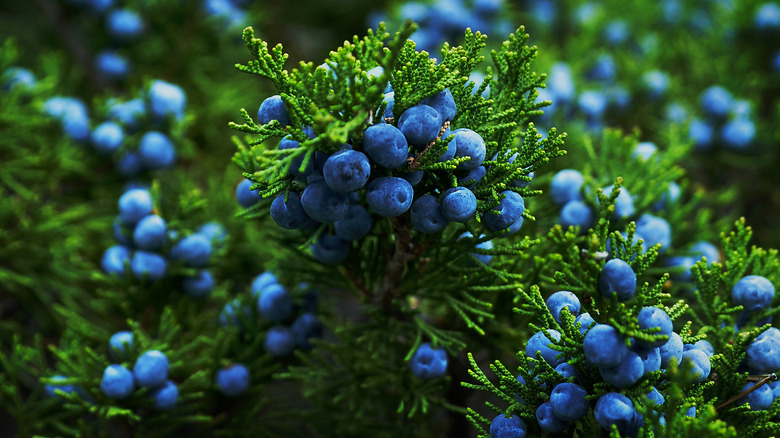The Type Of Berry That Gives Gin Its Distinct Flavor
Gin lovers have great drinks for all kinds of occasions. If you're at a formal event and want to drink as such, you can have a fancy French 75 cocktail to show off your sophistication. At a birthday bash, hand out glasses of Aperol gin punch so that its sparkling pink hue matches your colorful, celebratory atmosphere. During your next family barbecue, or even if you're just relaxing on your patio, have a last word – a traditional Repeal Day cocktail – for the perfect outdoor drink. No matter what gin cocktail you enjoy, it will likely boost your blood flow and always have that delicious pine-like, citrusy taste. That distinctive flavor is because gin is made with juniper berries.
Sometimes looks are deceiving, and juniper berries have a visual presentation that's so deceptive that they're improperly named. While they may appear to look like berries, they aren't at all. They're seed cones with so much skin that they look like berries. The juniper plant is primarily located in the United Kingdom and many parts of the northern hemisphere. When you taste that piquant, citrusy gin flavor, it comes from the juniper. This botanical has a fascinating history associated with medicine just as much as it's currently linked to gin.
The medicinal origins of juniper
Juniper may be considered an essential ingredient to make gin, but its first uses were for culinary and curative purposes. Alcohol was first utilized to maintain the medicinal properties of botanicals like juniper, but, given the tasty nature, it also made these botanicals easier to enjoy. During the medieval era, the Scottish infused whisky with juniper to make it taste better, and they also mixed the berries in their food because juniper helps digest food. The Dutch used juniper berries similarly throughout the 19th century, eventually giving birth to gin.
Throughout Europe and North America, juniper berries were used to remedy illnesses like cholera and tuberculosis, and athletes used them to increase their endurance. Juniper remains a medicinal resource to this day, as it's often used to help cure urinary tract infections. But if you're working with juniper, you're likely going to use it to infuse your own gin at home. And the process is quite simple.
How gin is made using juniper
You can easily make homemade gin with juniper berries. All you need is an unflavored base alcohol distilled from a neutral grain such as corn, wheat, or barley. Then, add the juniper berries and other botanicals so that the blend of their natural flavors and fragrances fills the alcohol. Your juniper berries can be whole, gently compressed, or roughly ground, or you can just press the oils and juices out of the berries to mix into your alcohol. You can also use juniper berries as a garnish for your drink.
As the juniper is mixed into your base spirit, the berries release terpene compounds into the alcohol. Infusing these compounds will give the spirit that signature flavor. But you should blend in other botanicals to give your drink a more pleasing and complex flavor profile. Some typical botanicals infused in gin include coriander seeds, which have a bitter and sweet flavor, and angelica root, which has a woodsy flavor. However, there are also other botanicals made to use unique gin flavors. But no matter what botanical blend your gin has, it'll have that special flavor from juniper.


